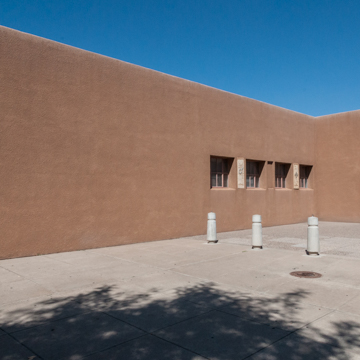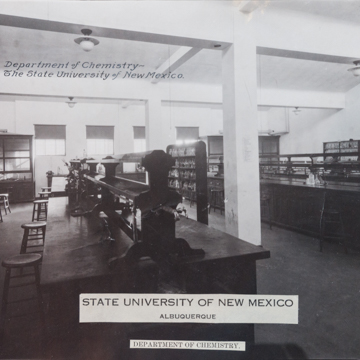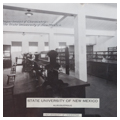You are here
Engineering and Science Computer Pod
The Chemistry Building is the only physical manifestation of the successive master plans that Walter Burley Griffin and Francis Barry Byrne produced for the University of New Mexico.
Designed by Byrne in 1916 and erected in 1917, the Chemistry Building followed Griffin’s more ambitious and monumental project of 1915 for a Science Building. Both reinterpreted, in modernist terms, the requirement that their buildings be in the Pueblo Style, a reflection of their experiences working for Frank Lloyd Wright in Chicago. Griffin mixed the Prairie Style with references to Mayan architecture, in a scheme whose banded massing, square windows with art glass, and the continuous horizontal of an ornamented soffit were consistent with his contemporary work elsewhere. Byrne combined the lessons of Louis Sullivan and Wright with what he called “the simplifying tendencies” of the Californian architect Irving Gill to produce an eloquently minimal rethinking of Griffin’s scheme.
The crisp massing is punctuated by a central entrance block with its wrought iron gate, recessed side wings whose abbreviated ranges of metal windows alternate with cast-stone panels, and a planned cast-stone cornice to hold the building’s top edge against the sky. Inside, classroom laboratories were placed to either side of a middle courtyard, which provided a well-ventilated space for chemistry experiments. The building’s modern construction of hollow terra-cotta tile walls finished with stucco, concrete floors, and a reinforced concrete saw-tooth roof was clearly expressed, and offered an alternative to the decorative pastiche of the remodeled Hodgin Hall.
John Clark, a professor of chemistry, contributed two panels of alchemical symbols to the building in 1928, but the rest of Byrne’s program of cast-stone ornament was never executed. When a new Chemistry Building was erected in the 1950s, the Old Chemistry Building became a departmental orphan, and was destined to give way in the 1980s to a new building and library for Electrical and Computer Engineering until the university architect, Van Dorn Hooker, argued successfully for its preservation. The new engineering building (and its underground library) stepped around the Old Chemistry Building, which was stabilized and restored in 1984–1986.
References
Brooks, H. Allen, Jr. “The Old Chemistry Building at the University of New Mexico.” New Mexico Architecture 2 (July–August 1960): 16-22
Chappell, Sally Kit, and Ann Van Zanten. Barry Byrne and John Lloyd Wright: Architecture and Design. Chicago: Chicago Historical Society, 1982.
Hooker, Van Dorn. Only in New Mexico: An Architectural History of the University of New Mexico. Albuquerque: University of New Mexico, 2000.
University of New Mexico. Department of Facility Planning Records. Center for Southwest Research, University Libraries, University of New Mexico.
University of New Mexico. Department of Facility Planning Drawings. Center for Southwest Research, University Libraries, University of New Mexico.
Writing Credits
If SAH Archipedia has been useful to you, please consider supporting it.
SAH Archipedia tells the story of the United States through its buildings, landscapes, and cities. This freely available resource empowers the public with authoritative knowledge that deepens their understanding and appreciation of the built environment. But the Society of Architectural Historians, which created SAH Archipedia with University of Virginia Press, needs your support to maintain the high-caliber research, writing, photography, cartography, editing, design, and programming that make SAH Archipedia a trusted online resource available to all who value the history of place, heritage tourism, and learning.




